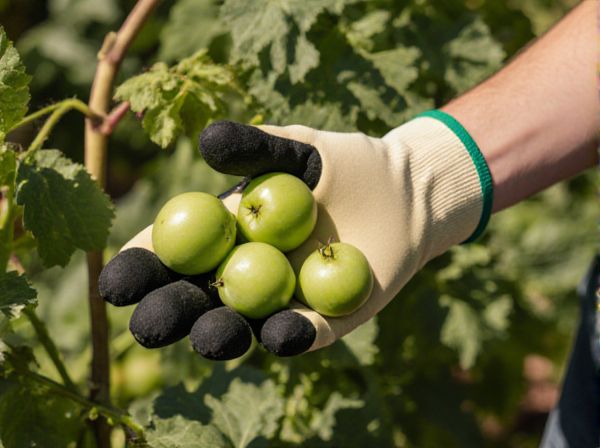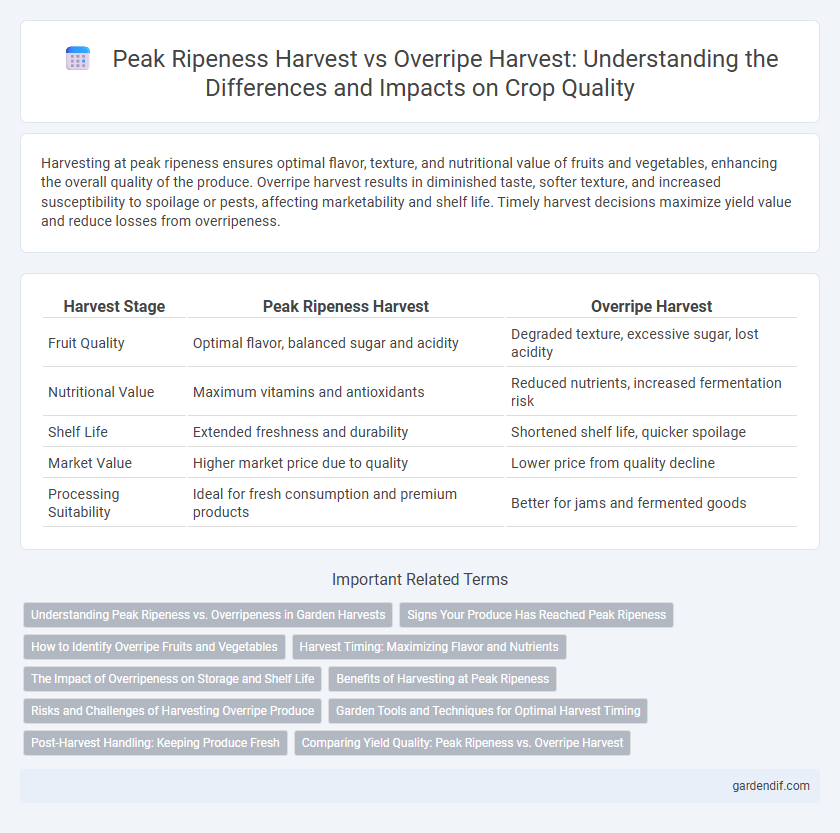
Peak Ripeness Harvest vs Overripe Harvest Illustration
Harvesting at peak ripeness ensures optimal flavor, texture, and nutritional value of fruits and vegetables, enhancing the overall quality of the produce. Overripe harvest results in diminished taste, softer texture, and increased susceptibility to spoilage or pests, affecting marketability and shelf life. Timely harvest decisions maximize yield value and reduce losses from overripeness.
Table of Comparison
| Harvest Stage | Peak Ripeness Harvest | Overripe Harvest |
|---|---|---|
| Fruit Quality | Optimal flavor, balanced sugar and acidity | Degraded texture, excessive sugar, lost acidity |
| Nutritional Value | Maximum vitamins and antioxidants | Reduced nutrients, increased fermentation risk |
| Shelf Life | Extended freshness and durability | Shortened shelf life, quicker spoilage |
| Market Value | Higher market price due to quality | Lower price from quality decline |
| Processing Suitability | Ideal for fresh consumption and premium products | Better for jams and fermented goods |
Understanding Peak Ripeness vs. Overripeness in Garden Harvests
Harvesting garden produce at peak ripeness ensures optimal flavor, nutrient content, and shelf life, while overripe harvests often result in diminished taste, softer texture, and faster spoilage. Recognizing indicators like vibrant color, firmness, and aroma helps distinguish fruits and vegetables ready for harvest from those that are overripe. Timely harvesting maximizes crop quality and reduces waste in home gardens and commercial agriculture.
Signs Your Produce Has Reached Peak Ripeness
Signs your produce has reached peak ripeness include vibrant color, firm texture with a slight give, and a fragrant aroma specific to each fruit or vegetable. Overripe harvest shows dull color, excessively soft or mushy texture, and often emits an unpleasant or fermented smell. Monitoring these sensory indicators helps ensure optimal flavor, nutrition, and shelf life when harvesting crops.
How to Identify Overripe Fruits and Vegetables
Overripe fruits and vegetables exhibit distinct signs such as excessive softness, dark or moldy spots, and an off or fermented aroma indicating spoilage. The skin may appear shriveled or discolored, and the flesh often becomes mushy with a sticky residue. Recognizing these characteristics helps avoid harvesting produce past peak ripeness, ensuring optimal flavor, texture, and nutritional value.
Harvest Timing: Maximizing Flavor and Nutrients
Harvesting at peak ripeness ensures optimal flavor concentration and maximum nutrient retention, as fruits and vegetables have fully developed their sugars, acids, and phytonutrients. Overripe harvests often result in nutrient degradation, diminished taste quality, and increased vulnerability to spoilage due to enzymatic breakdown. Precise timing guided by indicators such as color, firmness, and sugar content directly impacts the post-harvest quality and shelf life of agricultural produce.
The Impact of Overripeness on Storage and Shelf Life
Harvesting at peak ripeness ensures optimal flavor, texture, and nutrient retention while maximizing shelf life and storage quality. Overripe harvests lead to accelerated enzymatic activity and increased ethylene production, causing faster spoilage and reduced postharvest storage potential. Maintaining strict monitoring of maturity indices helps prevent overripeness, thereby extending marketability and reducing food waste.
Benefits of Harvesting at Peak Ripeness
Harvesting crops at peak ripeness ensures optimal flavor, nutritional content, and market value, while minimizing losses from spoilage or pest damage. Fruits and vegetables harvested at this stage exhibit ideal texture and sugar-acid balance, leading to enhanced consumer satisfaction and longer shelf life. Precise timing in peak ripeness harvest supports efficient supply chain management and reduces waste in agricultural production.
Risks and Challenges of Harvesting Overripe Produce
Harvesting overripe produce poses significant risks including increased susceptibility to bruising, faster spoilage, and reduced shelf life due to elevated sugar content and softer textures. Overripe fruits and vegetables often attract pests and diseases, complicating post-harvest handling and leading to higher post-harvest losses. These challenges result in decreased market value and profitability, emphasizing the importance of timely peak ripeness harvest to optimize quality and minimize waste.
Garden Tools and Techniques for Optimal Harvest Timing
Using precision garden tools such as digital refractometers and moisture meters can help determine peak ripeness by accurately measuring sugar levels and soil moisture for optimal harvest timing. Sharp harvesting tools like bypass pruners and ergonomic knives reduce damage to fruits and plants, preserving quality and extending shelf life. Implementing techniques like staggered picking and routine crop monitoring ensures fruits are harvested at their peak, avoiding overripe harvest that leads to spoilage and reduced market value.
Post-Harvest Handling: Keeping Produce Fresh
Peak ripeness harvest ensures produce is picked at maximum flavor and nutrient content, optimizing shelf life and reducing waste during post-harvest handling. Overripe harvest leads to quicker spoilage, increased susceptibility to bruising, and decreased marketability, demanding more careful temperature control and faster processing. Effective post-harvest techniques like rapid cooling, controlled atmosphere storage, and gentle handling are critical to maintain freshness and extend the usability of peak-ripeness produce compared to overripe counterparts.
Comparing Yield Quality: Peak Ripeness vs. Overripe Harvest
Harvesting crops at peak ripeness ensures optimal nutrient density, flavor profile, and market value, while overripe harvests often lead to nutrient degradation, increased susceptibility to pests, and reduced shelf life. Peak ripeness maximizes firmness and sugar content, crucial for crop variants like tomatoes and grapes, whereas overripe fruits exhibit softness, fermentation risk, and diminished commercial appeal. Yield quality is significantly higher at peak ripeness, promoting better storage potential and consumer satisfaction compared to overripe produce.
Peak Ripeness Harvest vs Overripe Harvest Infographic

 gardendif.com
gardendif.com